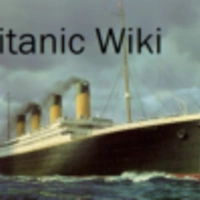The SS City of New York (most often known only as the SS New York) is famous for being the ship that almost collided with the RMS Titanic on April 10th, 1912 as the larger vessel was departing on her maiden voyage.
She had a career, ranging from passenger to military service, which lasted from 1888 to 1922.
History[]
The SS City of New York was built in 1888 by James and George Thompson, Glasgow, Yard No.240 for the Inman Line (Liverpool). She was launched on 15 March, 1888. At the time, she was the largest ship in commission in the world and the first twin screw (two propellers) liner to make the North Atlantic run. From August 1892 to May 1893, the New York held the Blue Riband for the eastbound Atlantic run.
In 1893, Inman line became part of the American Line. At this point, the ship was re-branded as SS New York. In 1898, she was renamed Harvard and used by the U.S. Government as an armed merchant cruiser during the Spanish American War. In 1899, she returned to civilian service with the American Line, and was once more renamed New York.
Following the war, she carried passengers on the New York-Southampton run. From 1901-1903, she underwent an extensive refit to replace her old machinery with triple expansion engines and to replace her three old funnels with two taller, new ones. Service was resumed on 14 April, 1903.
Near Collision with RMS Titanic[]
- Main article: Near-collision in Southampton
On 10 April, 1912, the New York was berthed in Southampton, alongside Oceanic, a White Star Liner. Both were docked due to a coal strike, and were not in service.

New York (middle), moored next to Oceanic (far left) drifts towards Titanic's (far right) stern.
At noon, when Titanic was scheduled to depart Southampton on her maiden voyage, tugboats towed the massive liner into the River Test. When Captain Smith ordered the acceleration of Titanic's engines, putting the larger ship under her own power, the suction created by the propellers at the stern of the ship caused the steel hawsers securing New York to snap, loosing her from her moorings with a sound likened to gunshots and causing her to drift toward Titanic's stern,
A quick order from Captain Smith to reverse the port propeller, and the timely action of a tugboat (Vulcan) prevented a collision: the captain of the Vulcan was able to throw a line to New York and sufficiently slow her drift, preventing her from hitting Titanic, while the wash from the Titanic's reversing propeller further pushed her away, averting danger. Another tug joined Vulcan and they were able to gain control of New York, but not before narrowly missing Oceanic as well as New York swung back the other way.
Later Service[]
In 1913, New York was re-configured to carry only second and third class passengers.
During World War One, New York was commissioned by the US Navy as a troop transport. She was renamed the Plattsburg. During her run as a transport, she was damaged by a mine. Following the war, she was renamed New York and reconditioned, which included removing one of the ship's masts.

The Plattsburg as a troop transport during WW1.
Her service as a passenger ship was resumed, following the war, in 1920. She served with the American Line for nine months, before being sold to the Polish Navigation Company. She had one voyage with that line, before they went bankrupt and the creditors requisitioned her, selling her in 1922 to the Irish American Line. She changed hands twice more, once to the United Transatlantic Line and, finally, to the American Black Sea Line.
Finally, in 10 June, 1922, she made her last Atlantic crossing from New York to Naples and Constantinople. Later in 1923, she was sold for scrap, ending her career.
